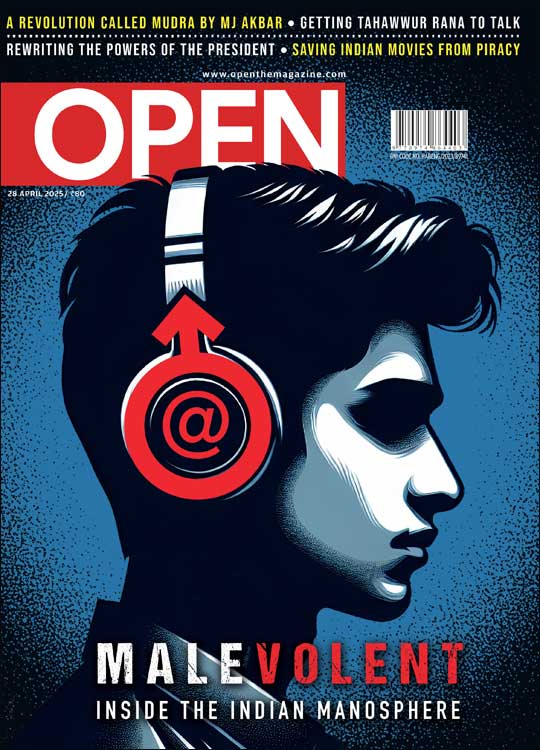Melodies out of Thin Air
Through practice and oral gymnastics, some Indians have elevated whistling to an art form
 Nandini Krishnan
Nandini Krishnan
 Nandini Krishnan
|
29 Dec, 2012
Nandini Krishnan
|
29 Dec, 2012
/wp-content/uploads/2015/11/whistler-1.jpg)
Through practice and oral gymnastics, some Indians have elevated whistling to an art form
Like most Gujaratis born in Madras, 65-year-old Jagat Tarkas runs a business in an old part of the city. Tarkas owns the Bombay Sports and Trophies shop in Triplicane. He delights in analogies that draw from cricket. He looks like the neighbourhood uncle who walks in the park in the mornings, listens to Kishore Kumar songs in the evenings, and can be prevailed upon to sing a Mohammed Rafi hit or two at celebratory gatherings. You don’t expect him to peel off his pin-striped shirt to reveal a lemon yellow T-shirt that says ‘Licensed Whistler’ on the front and ‘Whistle your worries away’ on the back. (Watch Video)
When I met him six years ago, he was running the Chennai chapter of the Indian Whistlers’ Association (IWA). This was a group of ten people, including 10-year- old Puja. He had emailed the radio station I worked for, asking for coverage of a whistling event he was organising in the city. Now the IWA has more than 400 registered members, most of whom are in Chennai. They have organised several whistling conventions in the city, at one of which they even set a Limca Book record.
Jagat’s association with the IWA began when he stumbled upon a website with yellow font on a purple background, run by Rigveda Deshpandey, a man who styled himself as ‘The Maverick Whistler’. Jagat called him up, and asked how he could become a member.
“He told me to audition on the phone, but I said, ‘It won’t come out properly, I’ll come to Pune and meet you’,” Jagat says, “I found there were only three fellows in [the IWA], two from Pune and one from Lonavla, and they would meet once in six months, whistle for some time and disperse. They were in touch only on mail.”
Jagat decided they should stage a show. He roped in a 19-year-old neighbour, Kruti Shah, and got the others to make the journey to Chennai. He emailed the media. On 18 June 2006, nearly 500 people turned up to watch five people whistle tunes of old Hindi songs, with an 8-year- old drummer providing background music.
“In that very programme, we found Puja,” recalls Jagat, “I told the audience I’d give them five minutes to perform. One man came and did something that didn’t sound like whistling. Then Puja came up and started crying. She was shy, her father had made her go up on stage. But when she could finally whistle, it was so effortless. That was a real find.” The story sets the eight people at the IWA meeting I’ve walked into reminiscing about their families’ attitude to whistling.
“In the South, especially, whistling is considered a Romeo act,” says Arunkumar, “Superstitious people say ‘It’s unlucky, you’ll blow your wealth away’. I remember, when I was about 17, my father heard me and was furious, and I wasn’t given food the entire day.” He pauses. “It was a beautiful song. Kahin Deep Jale from Bees Saal Baad. Later, my daughter would tell my wife to ask that ‘milk cooker’, meaning me, to stop. But when I joined the IWA, they realised it’s music. Raag is there, shruti is there, taal is there, bhaav is there, it’s not just this…” he says, as he demonstrates a wolf whistle. “Then my daughter got interested, and started performing in her college. They used to call her ‘Whistle Bhavani’.”
The association takes its whistling seriously. It collects annual fees from all members. Those who can’t afford Rs 1,800 a year are allowed to pay in instalments, or have others chipping in, as is the case of a sign painter they are keen to have as a member.
They meet once a month, after settling on a theme— rain songs, dance numbers, songs about flowers and so on—and search for ‘minus one’ tracks (instrumental versions of songs). They even hold contests. Things got easier once MR Subramaniam, a bearded man who organises light-music concerts, joined the club. He finds karaoke tracks, gets equipment for meetings (a microphone and amplifier), and helps invite judges for contests. “We call external judges: singers, keyboard players, flautists, someone with a sense of music,” Subramaniam says. “There are two categories for the monthly contest— Inspiring and Aspiring—with separate prizes.” They audition prospective members and train them.
“There’s a lot to keep in mind,” says Subramaniam, “Where to start, how to follow the beat, how to stop and fade in with the music, where to bring in emotions, how much to give the mike.” Most people end up contorting their faces and swinging their heads away from the mike, like Carnatic singers often do. “If they need to express themselves like that, we teach them mike management: how to press it against your cheek, like this”—he demonstrates—“ and move your hand in sync with your head.”
Says Jagat, “The problem is, most people want an immediate platform to perform. But we can only do two-three shows a year. Each costs us about a lakh [rupees]. And only 10-12 people can whistle at each. So of every ten new people who land up, only one remains. It’s all aaya Ram, gaya Ram. Like our Indian batting.”
Sitting among seven men is the pleasant-faced, husky-voiced Chaitanya, a doctor-turned-designer whose husband found an article on the IWA and asked her to audition. “We were told whether we’re good, whether we had potential, how we could improve,” she says, “And we’re given a lot of training before shows.”
Subramaniam, who’s eager to demonstrate his repertoire and says he can both sing and whistle in male and female pitches, handles the training. “Like an artist records a vision and translates it into a painting, we need to listen to songs and translate them into whistles. It’s difficult to take in something if you don’t understand it. Chaitanya doesn’t speak Tamil. So some of us explain the song, and tell her what the mood of the whistle should be.”
The association is especially proud of its women whistlers. “I’ll tell you why women are so good,” Jagat says, “Most men are addicted to something—cigarettes, Pan Parag, beeda, alcohol. And they don’t walk, cook, do yoga, or any household work. They just sit in offices all day, and are out of exercise. Third, most men are lazier than women; they won’t bother practising, but when a woman takes up something, she gives it her best.”
“A lot of girls also learn music,” adds Srikanth, a quiet man who would listen in on his sisters’ music lessons and implement their singing technique in his whistling.
“In fact, one girl came to me to learn whistling,” Arun- kumar cuts in, “We had a programme in our apartments, and I whistled Mere Sapnon ki Rani. The next day, someone came with betelnuts and money on a tray, like you do for your gurus, and said, ‘Can you kindly teach my daughter to whistle?’ My wife told me to put a board outside, saying ‘Whistling teacher’. More betelnuts would come.”
Chaitanya, however, detects a prejudice against women whistlers. “It’s a good draw, because people are curious whether women can really whistle. But, you know, whistling is seen as taboo in Indian society anyway, and only tolerated as a boys-will-be-boys thing.”
“Once,” says Jagat with a grin, “One of our girls was whistling, and someone asked, ‘Ghar mein baap-bhai nahin hai, kya?’ She replied, ‘Hai na, unn hi ne sikhaya hai’.”
As the others clutch their stomachs, Arunkumar tells us how Whistle Bhavani’s matrimonial match was arranged. When it was time for the bride to sing for the prospective in-laws, the groom’s family asked her to whistle instead. “For her wedding kutcheri, we’re all performing. Two hours of Carnatic whistling.”
They’ve even whistled at temples, says Subramaniam, whose garb indicates he’s about to make a journey to Sabarimala. “We’ve done a whistling programme at Koothanoor Saraswathi temple. During Ayudha Puja, people like MS Subbulakshmi used to sing there. And we perform every Tamil New Year’s Day, 14 April, at a Durgalak- shmi temple.” “It’s an art,” Arunkumar says, again.
“And it’s a science,” adds Jagat, “It’s good for the lungs, for the brain, and it makes you happy. We look after our throats. Some people take ayurvedic medicine, some people drink water or chew cloves during performances. We look at ways to improve. See, I myself couldn’t whistle tunes in the beginning. When I decided to try, I started with flatter songs, without too much up and down, you know… like Jalte Hain Jiske Liye. Or in Tamil, Kanne Kalaimaane, Neeyum Bommai Naanum Bommai. The emotion is intense, but tuning not much. Next, I tried slightly tougher ones like Yeh Shaam Mastani. The next step is Naal Podhuma, Oru Naal Podhuma [a song sung by Balamuralikrishna for the 1960s Tamil film Thiruvilayaadal].”
Can whistling be taught? “It can be fine-tuned,” says Jagat, “That’s our job. We see if you have potential, then we work on technique. We can coach. See, a team coach needn’t be a Test player.”
He asks me to try, and I whistle the first few bars of Yeh Shaam Mastani. The whistlers look at me, heads cocked, eyebrows knitted in frowns of concentration.
“You’re not new to whistling,” says Jagat. “You’re not throwing words into it. Some people will do this…” At this, he whistles a broken version of Dhoom Machaale. “You can hear them draw in breaths between words. You’re carrying a melody. But the whistling isn’t in sync with the emotion and nuances of the tune. Initially, play the song and perform with the song. Is Kishore Kumar saying ‘mastani’, ‘mas-ah-tani’, ‘mas-u-tani’, or ‘mas-i-tani’? You should bring that inflection in. Don’t go by lyrics alone. When he’s singing ‘ooo-ooo-ooo-oo-ooo’, see how many climbs there are. Once you sync with that, bring in emotion. You should sound like the evening is happy, breezy, fun. There’s a Tamil song, Ponaal Pogattum Poda. It means, ‘If it’s gone, let it go.’ You need to sound like you don’t care, you’ve given up. If there’s a question, like ‘Baat jab main karoon, mujhe rok deti hai kyon?’—he’s asking, ‘Why are you stopping me?’—your whistling has to show that.”
The association doesn’t restrict itself to ‘pucker whistling’, as what we usually do is called. It has teeth whistlers, roof whistlers, warble whistlers and other types. Sathyanarayana is a finger-whistler; Jagat’s nephew Abhishek can render an entire song drawing whistles inward and breathing out.
“One of our whistlers went to the Anu Malik show, Entertainment ke liye Kuchh bhi Karega. He whistled through his teeth, and Anu Malik said, ‘I think you’re playing something somewhere. You’re not moving your mouth. Demonstrate again.’ And he said, ‘I’m teeth whistling. And I can also do this while miming something.’ And he did the same thing, while pretending to shave,” says Jagat with a laugh.
IWA members have been to other reality shows too, apart from many whistling conventions. “It’s hard to compete with international whistlers for stamina, but no one has the melody we have [in India].”
“In China, we did a skit by whistling. It was a Bollywood type love story. A boy and girl fall in love, and we whistle a romantic song. The parents don’t accept it, so we do an angry song. Then, the girl and boy do a hartaal, so we do both angry and mournful songs. Finally, everyone comes to terms with it, so we do a group song.” That got them third prize and an article in a Chinese newspaper that none of them can read but each has kept.
Their big dream is to organise a televised whistling contest along the lines of Indian Idol. Jagat is absolutely determined to see it materialise. But for now, his pet project is convincing the Chennai Super Kings to let them whistle the team’s anthem, ‘Whistle Podu’, at IPL matches in Chepauk.

/wp-content/uploads/2025/04/Cover-Manosphere.jpg)











More Columns
Pak Fingerprints Over Killing of Tourists in Pahalgam Siddharth Singh
Constitutional offices are not ceremonial or ornamental: Dhankar Open
The Language of Power V Shoba